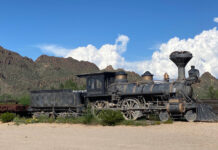By Mark Bassett
Executive Director Nevada Northern Railway
The long awaited forensic audit of Nevada Northern Railway was released last week by Larry Bertsch, CPA. In his presentation, Mr. Bertsch stated, “…the railroad is on a ‘going out of business’ curve.” Candidly, to those of us involved in the railroad, this news comes as no surprise. Money is always very, very tight at the railroad, yet somehow, we keep the doors open and the trains running.
The railroad has been short of money since the day it was given to the City of Ely and the Foundation. It was an incredible gift that was given to the community by Kennecott, but it was a gift that was given without money. It would be up to the Foundation to raise the money to keep the railroad alive, not the City of Ely taxpayers.
And what a gift it was and is; over seventy buildings and structures, thirty miles of railroad track, one steam locomotive, three diesel locomotives, about 100 antique railroad cars and an incomparable historic paper record. On top of all that, the Foundation is also responsible for the roads and the utilities on the railroad grounds: water, sewer, electricity and phone. Essentially, it is a small city, but without a tax base.
Candidly, the railroad should have failed financially a long time ago. If you are looking for proof that the age of miracles is not yet over, I submit the Nevada Northern Railway, National Historic Landmark in Ely, Nevada, as proof that miracles still happen today.
As Mr. Bertsch stated, yes, we should have gone out of business already, but yet, somehow, we have not only survived, but against impossible odds, we have flourished.
When the community asked for the railroad, the economic future of the community was bleak. The mine had already closed and then the smelter closed. The major employer was gone and so were all of the jobs. Anywhere else people would have thrown up their hands and said, ‘woe is me.’ But in Ely, the community had the guts to think that they could use the Nevada Northern Railway as an economic generator for the community. And those farsighted individuals were right. Since the trains started running, the railroad has brought approximately $72,000,000 into our community. And this is the great irony – the vast majority of that money went into the community and not into the railroad.
Last year the railroad generated about $4,000,000 for the community and our income from train operations and the gift shop was $344,098. What that means is – that for every dollar the railroad brings into the community, it receives 9¢, the other 91¢ goes into the community creating jobs and economic growth.
So how does the railroad survive? When I started as Executive Director in July 2002 in the previous two years, the railroad had losses of over $1,000,000. Locomotive 40 was out of service needing $500,000 in repairs before she would run again. On the building front: the Machine Shop/Enginehouse building, the Master Mechanic Building, the Bus Barn, the Blacksmith Shop, the Chief Engineer’s Building, the Material Storage Building, Air Brake Building, the Wrecker Shed and the McGill Depot all had grave structural issues, and some of the buildings were on the verge of collapse.
And if that was not enough, the railroad had track issues, bridge issues, tunnel issues, highway crossing issues and the electrical wiring throughout the railroad was dangerous. And to top it off, the bank account was empty. Mr. Bertsch should have seen our books then.
So what happened? Lots! On every front! New Management Board members were recruited, grants were written, more trains operated, more volunteers were recruited and a dynamic membership program was started.
Slowly, like one of our steam locomotives starting up, things started to turn around. In 2002, we started to stop the bleeding of money. In 2003, we made money, in 2004, we lost, 2005 in the black, 2006, 2007 and 2008 all in the red. Then in 2008, JACKPOT! $1,646,485 in the black! Since 2002, even with all of the losses, the Foundation ended up $2,429,385 in the black.
So if the Foundation made all of that money, why is the Foundation always broke? Why is it in debt? And what is that debt? And is the Foundation paying down that debt and can the City of Ely taxpayers get struck with that debt. Good questions all.
Let’s start with why is the Foundation always broke? Remember those eight buildings with grave structural issues? All of them have been stabilized except one. On his last walk-through of the Machine Shop/Enginehouse building, the structural engineer said, “This building will stand for another hundred years.” That was a huge change from, ‘…the building is condemned and people should not be allowed in it.’
Steam locomotives 40 and 93 are in service, along with diesel locomotives 105, 204 and 310. The passenger coaches, 5, 7, 8, 9 are in service, along with cabooses 3, 6 and 22. Track, railroad crossings, bridge and tunnel issues have all been addressed. Electrical, water and sewer issues have also been addressed.
Why is the Foundation in debt? Debt is an aspect of doing business. We needed to borrow money to keep our steam locomotives in operation. Without our operating steam locomotives, visitors won’t make the drive to Ely. We learned that lesson in 2008. Would the Management Board prefer that the Foundation be debt free? Yes, in fact that is one of the goals of the Management Board and has been for years.
As of February 28, total debt of the Foundation was $468,467. This is down $49,551 from last year. The Foundation’s debt peaked at $2,419,411 in 2008. Since that time the Foundation has been aggressively paying down its debt with money it has raised and not with taxpayer’s money. There has always been a separation between the Foundation’s money and taxpayer’s money. This separation needs to continue.
Are the City of Ely taxpayers liable for the debts of the Foundation? Yes, but and this is a very big BUT, if the Foundation were to close tomorrow and had to liquidate its assets, it would have enough unrestricted assets to pay off all of its debts and still have money. Unfortunately, if we were to do this, we may not have an operating railroad anymore. That would be like throwing the baby out with the bath water, not a very smart move.
Since 2002, the Foundation has raised over $15,000,000 and invested that right back into the railroad. Our operating income has gone from $281,518 to $1,517,052 in 2012. While that is admirable, the fact of the matter is that we need to raise another $20,000,000. Can we do it? Yes! Will it be easy? No, but it can be done.
The Bertsch report makes valid points. A lot of the issues he raises are a result of our growth and having to make crucially needed repairs when we didn’t have the money to do so. But the elephant in the room that his report does not address, is how to overcome our chronic cash flow problem?
The Management Board is painfully aware of the cash flow problem of the Foundation. For the past year, it has been developing the Phoenix Dare. The goal of the Dare is to insure that the museum can accomplish its mission and become financial sound. The Phoenix Dare is a Capital Campaign to develop the financial resources needed to keep the railroad on track! The first phase of the Dare is to raise $2,000,000 in 2 years over and above our regular income stream. Future phases will attack the remaining $18,000,000 needed by the Foundation.
Mr. Bertsch is wrong in his assessment. We are not on a going-out-of-business curve. The Foundation has survived train wrecks, earthquakes, track issues, bridge issues, expensive locomotive repairs and the Great Recession. Rather, the Management Board is confident that the future of the railroad is bright. And this is said based on history, experience and the numbers.














